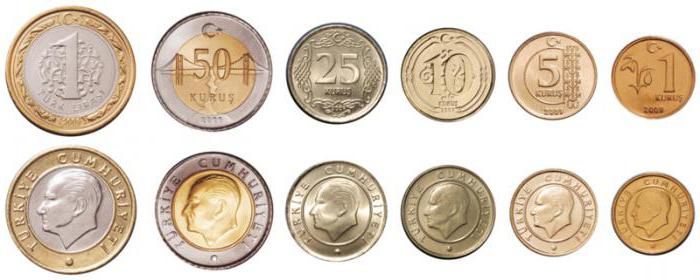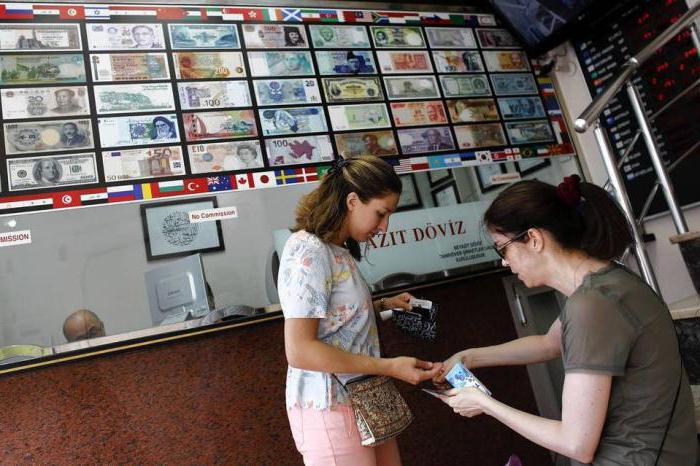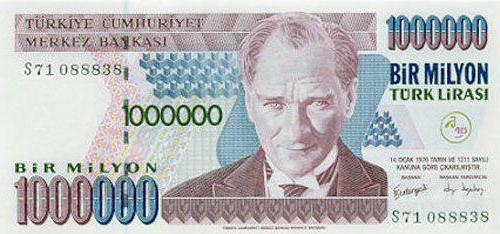The modern currency of Turkey appeared in 2005. It was at this time that her denomination was held in connection with a strong depreciation. At the same time, the value of the monetary unit increased significantly (in 1 million), although its name has existed since 1923. Initially, the Turkish currency was called the new lyre, but since 2009, the long-established name has returned.
Monetary units of Turkey
The Turkish lira with respect to small banknotes of kurush (yeni) is 100 units. The largest banknote is 200 lire; the nominal values 1, 5, 10, 20, 50 and 100 units are also included in the turnover. An additional 1 lira coin is issued, as well as 1, 5, 10, 20 and 50 yeni in the form of notes.

Features of the use of currencies and other payment methods
If you want to buy bargains in Turkey, it should be borne in mind that the Turkish lira is not the only desired acquisition for many merchants. Paying for goods in dollars often saves you money when traders offer discounted prices.
When traveling to Turkey, it is recommended that you keep small dollar or euro bills with you. It should be borne in mind that Turks, especially in the market, offer an inflated price, and do not take into account the differences between popular foreign currencies. You should actively bargain (such is the rule of the East) with the attitude that every lira, dollar or euro matters. Be friendly, smile more, and then you are surely guaranteed a good deal.
You should also behave correctly if an agreement is not reached: leave with a smile. In this case, the seller can follow the customer in order to keep him and offer a better price or find similar goods cheaper in a nearby location. Tourists are the main income of the merchants, so it is in their interest to make a deal.
The only place where US dollars are not accepted are supermarkets. In ordinary stores, you should not count on small change; it is better to have the exact amount with you.
Naturally, in addition to cash in Turkey, all kinds of bank cards are accepted with the function of international payments, but there are pitfalls in the form of an additional commission without warning (usually 5-7% of the amount). People traveling little in Western countries should remember that ATMs are easier to find by naming the abbreviation ATM. They are in almost any town, often equipped with the ability to choose the language, work with credit cards and around the clock functioning.
In Turkey, there is also the opportunity to pay for hotel services using special bracelets or “beads”, the receipt of which is paid without a refund.
Currency exchange
In Turkey, currency exchange is publicly available. There is a risk of being cheated on the black market. Private points offer a good course, while in hotels and banks it is less profitable. A commission is possible for the operation, which is indicated in the ads.

The Turkish currency is distinguished by features that must be considered when purchasing it:
- Low stability, therefore, it is more optimal to change the currency to national, only when you arrive in the country.
- It is recommended to exchange small amounts - the course skips all the time.
- If it is desirable to use dollars or euros in small bills, then accepting small banknotes or coins of the Turkish currency is risky. They can be removed from circulation at any time. Of course, such a probability is not always realized.
In Turkey, when leaving, it’s hard to pass the lira in exchange for foreign currencies. The country's banks issue confirmation of the exchange, and it is this that guarantees the subsequent disposal of unnecessary cash balances. Banks operate regularly in resort areas, but at the weekend the exchange rate is disadvantageous. Optimal days are Tuesday or Wednesday.
Currency Rates
At the start of 2016, the Turkish lira to the ruble was approximately 1:25. Starting in September 2015, the value of the currency is constantly increasing. It should be noted that in January 2015 there was an even more active growth in the currency. Then the ratio was a little more than 1:27 rubles.

The rate of the Turkish lira to the dollar at the beginning of 2016 was 1: 0.33. Since September 2015, the value of the currency has varied in the range of 0.32-0.35 against the dollar. A strong drop (from 0.38 to 0.33) of the exchange rate was observed in July-September 2015.
Briefly about the appearance of banknotes
Before leaving for any country, you must familiarize yourself with its banknotes, since no one canceled the fakes. The currency of Turkey regarding banknotes has one common feature - the image on the front side of the first President Ataturk. You can distinguish bills on the reverse side.

Examples of lyre illustrations:
- 5 lire - a specialist in the history of Sayyly Aydin, as well as a schematic illustration of the solar system and DNA.
- 10 - mathematician Jahid Arfa and his calculations.
- 20 - Architect Kemaleddin Bey and his project (Gazi University Building).
- 50 - the first author of novels among representatives of Islam (Fatma Aliye Topuz), as well as books and papers symbolizing her work.
Thus, when visiting Turkey, you need to know a number of rules for using its national currency. Owning information is a guarantee of travel without significant loss of money.
